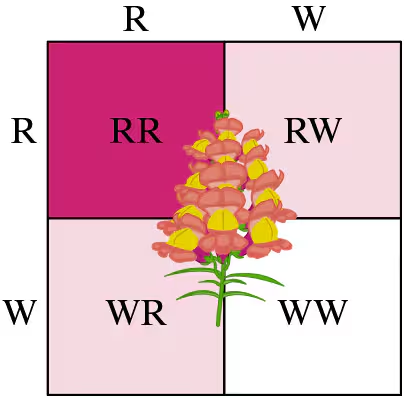Table of contents
- 1. Intro to Stats and Collecting Data55m
- 2. Describing Data with Tables and Graphs1h 55m
- 3. Describing Data Numerically1h 45m
- 4. Probability2h 16m
- 5. Binomial Distribution & Discrete Random Variables2h 33m
- 6. Normal Distribution and Continuous Random Variables1h 38m
- 7. Sampling Distributions & Confidence Intervals: Mean1h 3m
- 8. Sampling Distributions & Confidence Intervals: Proportion1h 12m
- 9. Hypothesis Testing for One Sample1h 1m
- 10. Hypothesis Testing for Two Samples2h 8m
- 11. Correlation48m
- 12. Regression1h 4m
- 13. Chi-Square Tests & Goodness of Fit1h 20m
- 14. ANOVA1h 0m
4. Probability
Basic Concepts of Probability
Problem 3.1.81c
Textbook Question
81. Genetics A Punnett square is a diagram that shows all possible gene combinations in a cross of parents whose genes are known. When two pink snapdragon flowers (RW) are crossed, there are four equally likely possible outcomes for the genetic makeup of the offspring: red (RR), pink (RW), pink (WR), and white (WW), as shown in the Punnett square at the left. When two pink snapdragons are crossed, what is the probability that the offspring will be (c) white?

 Verified step by step guidance
Verified step by step guidance1
Step 1: Understand the problem. The question asks for the probability that the offspring will be white (WW) when two pink snapdragon flowers (RW) are crossed. The Punnett square provided shows all possible genetic combinations.
Step 2: Analyze the Punnett square. The Punnett square shows four equally likely outcomes: RR, RW, WR, and WW. Each outcome represents a genetic combination of the offspring.
Step 3: Identify the desired outcome. The problem specifically asks for the probability of the offspring being white (WW). Locate the WW cell in the Punnett square.
Step 4: Count the occurrences of the desired outcome. In the Punnett square, there is one WW cell out of the four total cells.
Step 5: Calculate the probability. Since each outcome is equally likely, the probability of the offspring being white (WW) is the number of WW outcomes divided by the total number of outcomes, which is 1/4 or 25%.
 Verified video answer for a similar problem:
Verified video answer for a similar problem:This video solution was recommended by our tutors as helpful for the problem above
Video duration:
1mPlay a video:
Was this helpful?

 5:37m
5:37mWatch next
Master Introduction to Probability with a bite sized video explanation from Patrick
Start learningRelated Videos
Related Practice

